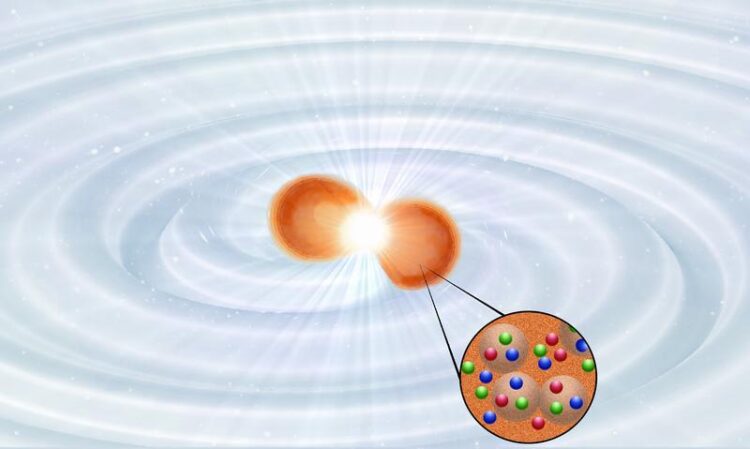Colliding stars reveal fundamental properties of matter and space-time

Collision of two neutron stars showing the electromagnetic and gravitational-wave emission released during the merger process. The combined interpretation of multiple messengers allows it to understand the internal composition of neutron stars and to reveal the properties of matter under the most extreme conditions in our Universe. Image credit: Tim Dietrich
Combining various observational data of neutron-star collisions with nuclear-physics calculations, Tim Dietrich, Astrophysics Professor at the University of Potsdam, and an international science team made a breakthrough in constraining the size of a typical neutron star and in measuring the expansion rate of our Universe, determined by the Hubble constant. Their results have now been published in the high-ranking journal Science.
In modern astrophysics, scientists combine different types of signals from space, in particular light, cosmic particles, and gravitational waves, to answer fundamental questions of cosmic history. This method of multi-messenger astronomy is a rapidly growing field, where the cosmic messengers in the electromagnetic spectrum of light encompass, e.g., gamma rays, ultraviolet, visible, infrared, and radio. Messenger particles can be electrons, protons, neutrinos, complex atomic nuclei and other.
Finally, gravitational waves are tiny ripples in the fabric of space-time itself, generated by accelerated masses as neutron stars or black holes, that emerge from dying stars after the end of their lives. Especially from colliding neutron stars, astronomers can depict the properties of matter at very high densities exceeding the density inside atomic nuclei, i.e., matter for which a single teaspoon of material would weight inconceivable several million tons. Colliding neutron stars produce most of the heavy elements in the periodic table, and they allow for measuring the expansion rate of our Universe.
To unravel the mysteries of the underlying physical processes during neutron star collisions, researchers from Germany, the Netherlands, Sweden, France, and the USA incorporated observations of neutron-star collisions with signals both across the full electromagnetic spectrum and in gravitational waves. “We developed an interdisciplinary framework combining the observations with theoretical nuclear-physics calculations to extract astrophysical information on these systems and matter under extreme conditions. With our method, we were able to constrain the size of a typical neutron star to be ~12 km, i.e., a neutron star is an object with the size of a single city, but with a mass several hundred thousand times the mass of the Earth”, says Tim Dietrich, Professor for Theoretical Astrophysics at the Institute of Physics and Astronomy.
Further, the team used the extracted astrophysical information to determine the Hubble constant, a fundamental constant that describes the expansion of the Universe. “In the last few years, the scientific community tried to resolve tension among different determinations of the expansion rate of our Universe. Our new framework allowed us to re-measure the Hubble constant, and the final results show a mild preference for the previous Cosmic Microwave Background measurement,” adds Ingo Tews, staff scientist at Los Alamos National Laboratory and co-author of the study.
Starting from theoretical input that describes the nuclear matter in the core of neutron stars, the researchers analyzed astronomical data in a multi-step procedure. “We included neutron-star mass measurements through radio observations, the observation of a rapidly spinning neutron star, and observations of neutron star mergers via gravitational waves and electromagnetic signatures”, Tim Dietrich explains the methods, “for the latter, we scanned the entire frequency spectrum ranging from the radio band to gamma-rays.” The developed framework is general and can easily be extended to include an increasing number of detections of multi-messenger signals in the coming years, he summarizes.
Publication: Tim Dietrich, Michael W. Coughlin, Peter T. H. Pang, Mattia Bulla, Jack Heinzel, Lina Issa, Ingo Tews, and Sarah Antier: Multi-messenger constraints on the neutron-star equation of state and the Hubble constant, Science 370, 1450 (2020), https://doi.org/10.1126/science.abb4317
Science_Dietrich: Collision of two neutron stars showing the electromagnetic and gravitational-wave emission released during the merger process. The combined interpretation of multiple messengers allows it to understand the internal composition of neutron stars and to reveal the properties of matter under the most extreme conditions in our Universe. Image credit: Tim Dietrich
Contact: Prof. Dr. Tim Dietrich, Institute of Physics and Astronomy, Tel.: +49 331 977-230160, Mobile: +49 177 7084084, E-Mail: tim.dietrich@uni-potsdam.de
Medieninformation 18-12-2020 / Nr. 120
Dr. Stefanie Mikulla
Universität Potsdam
Referat Presse- und Öffentlichkeitsarbeit
Am Neuen Palais 10
14469 Potsdam
Tel.: +49 331 977-1474
Fax: +49 331 977-1130
E-Mail: presse@uni-potsdam.de
Internet: www.uni-potsdam.de/presse
Media Contact
All latest news from the category: Physics and Astronomy
This area deals with the fundamental laws and building blocks of nature and how they interact, the properties and the behavior of matter, and research into space and time and their structures.
innovations-report provides in-depth reports and articles on subjects such as astrophysics, laser technologies, nuclear, quantum, particle and solid-state physics, nanotechnologies, planetary research and findings (Mars, Venus) and developments related to the Hubble Telescope.
Newest articles

Innovative 3D printed scaffolds offer new hope for bone healing
Researchers at the Institute for Bioengineering of Catalonia have developed novel 3D printed PLA-CaP scaffolds that promote blood vessel formation, ensuring better healing and regeneration of bone tissue. Bone is…

The surprising role of gut infection in Alzheimer’s disease
ASU- and Banner Alzheimer’s Institute-led study implicates link between a common virus and the disease, which travels from the gut to the brain and may be a target for antiviral…

Molecular gardening: New enzymes discovered for protein modification pruning
How deubiquitinases USP53 and USP54 cleave long polyubiquitin chains and how the former is linked to liver disease in children. Deubiquitinases (DUBs) are enzymes used by cells to trim protein…


